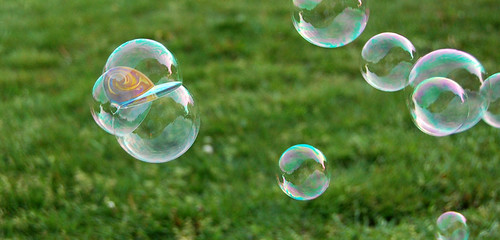
CC | Click on image for license and information.
I?ve only been to Disney World once. A few years ago, S and I went for the first time and while I may go back, I?m definitely still recovering. Disney marketing isn?t kidding when they say it?s the happiest/most magical place on earth?it?s intense. And the experience stays with you. The promise of the experience draws lots of people: Disneyland receives approximately 10 million visitors annually (1). And lots of folks are repeat visitors. It may not be for everyone: I know people who absolutely refuse to have anything to do with the magic, as well as some who aren?t comfortable around costumed representatives, but they seem to be in the minority given the volume these places experience. Researchers have suggested that Disney generates a successful experience because our brains are responsive and receptive to art, creativity, storytelling, humor, wit, music, fantasy, and morality, all of which may have been important to social development?and feature heavily in the ?Disney experience? in a rather amplified way.
Humans have large brains, which are really expensive to produce. Researchers have not yet determined why our brains are so large, but everything from diet to climate change to social competition to changes in gestation has been proposed. Geoffrey Miller, an evolutionary psychologist, suggested that big brains are a result of sexual selection. He argues that the brain is ?an entertainment system that evolved to stimulate other brains? in an effort to attract mates (2). Miller?s ?mating mind hypothesis? states
he large size of the brain evolved because mates (in most cases females) favoured a mate (in most cases males) with increased abilities to produce such aspects of culture as art, creativity, storytelling, humour, wit, music, fantasy, and morality (3).
These ?courtship tools? are meant to attract sexual partners. However, Miller?s hypothesis is not supported by the actual development of the human brain, which does not display the characteristics of a sexually selected trait. Two of the the major points of divergence that researchers Palmer and Coe discuss are the lack of sexual dimorphism and the actual growth of the brain. Male brains do not significantly differ from female brains:
Although there do appear to be clearly evolved sexual differences in specific parts of the brain directly related to mating (e.g., mate preferences, jealousy), there are no similarly striking differences related to production of and responsiveness to the traits he is attempting to explain (art, creativity, storytelling, humour, wit, music, fantasy, and morality) (4).
And if the brain were a sexually selected feature, it would become more prominent after puberty. This isn?t the case: The human brain weighs about 25% of its adult weight at birth, and it doubles in weight in about 6 months. At puberty, there isn?t another of these types of gains. The brain completes most of its development within the first few years of life.
As an alternative to understanding why specific forms of entertainment are so appealing, Palmer and Coe instead suggest they reflect parenting strategies to influence the behavior of offspring. The ?parenting mind hypothesis? proposes that the size of the human brain developed via natural selection in response to parental ability to influence behavior?big brains allowed offspring to store and replicate behaviors modeled by parents that enabled survival and reproduction (5). This latter hypothesis takes into account one possible reason why children develop language skills so early in life: language helps them receive information from their parents, which increases their fitness for survival.
Where does the Disney franchise fit in this discussion? Palmer and Coe propose that Disneyland (which is not Disney World, but the experience is essentially the same, I would imagine: extreme stimulation of the senses) is an extension of the traits that are important to the parenting mind hypothesis:
Although Disneyland and fairy tales in general are often mistakenly seen as mere entertainment, they both clearly provide moral lessons. Pinocchio warns children not to tell a lie. Cinderella tells children that virtue has rewards, and the three pigs teach children about planning and industriousness (6).
They suggest that our susceptibility to these forms of entertainment allow Disneyland?and other forms of art and entertainment?to exist. But I would amend that to say that our potential susceptibility to these traits allows the Disney franchise and other good examples of art, creativity, storytelling, humor, wit, music, fantasy, and morality?such as movies and plays?to be successful because they help us construct (non-sexual) social connections.
One of the things I wish this paper had discussed a bit more was the connection between relationship building and the traits linked to the Disney experience. Art, creativity, storytelling, humor, wit, music, fantasy, and morality may be important elements in the relationships we develop and maintain?not in a sexual sense, but in terms of network building. The researchers touch upon this briefly in their conclusion, and it seems to warrant exploration because it has broad implications in terms of how our social networks are engaged with these traits. When we experience an instance of storytelling or humor or music with someone else, we?re creating a bond through that experience that helps define our places within our network relative to each other. Revisiting these experiences could then be an act of reaffirming ties?which could help us understand why people return to Disney theme parks and other forms of creative entertainment.
Note: This post was pulled from the AiP archives?a version of this post appeared on anthropologyinpractice.com on March 8th, 2011.
Cited:
Craig T. Palmer, Kathryn Coe (2010). Parenting, Courtship, Disneyland, and the Human Brain International Journal of Tourism Anthropology, 1 (1), 1-14 : 10.1504/IJTA.2010.036843
Notes:
1. Palmer and Coe 2010: 2 | 2. Palmer: 2 | 3. Palmer: 3 | 4. Palmer: 4 | 5. Palmer: 5 | 6. Palmer: 10
Source: http://rss.sciam.com/click.phdo?i=606812e5322ec406749e455f7032b0ce
Waldo Canyon fire nba finals K Michelle roger clemens multiple sclerosis falling skies rodney king
কোন মন্তব্য নেই:
একটি মন্তব্য পোস্ট করুন